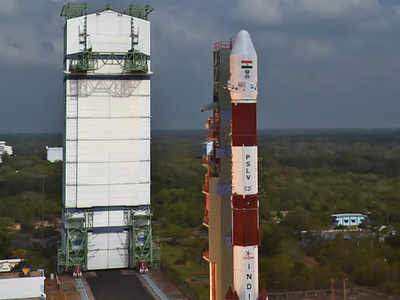- News
- India News
- Isro to again showcase multiple-burn tech
Trending
This story is from January 11, 2018
Isro to again showcase multiple-burn tech
ISRO news: On Friday, when PSLV-C40 takes off on its 42nd flight, it will once again demonstrate the multiple-burn technology where the fourth stage engine will be ignited and shut off four times to place 31 satellites, including small ones, in different orbits.

Key Highlights
- Isro on Thursday began countdown for launching 31 satellites on Friday.
- The 28-hour countdown began at 5.29am today in the mission control centre.
- The PSLV-C40 will also place Isro’s 100th satellite in orbit.
CHENNAI: The Indian Space Research Organisation began a 28-hour countdown for the launch of PSLV-C40/Cartosat 2 Series satellite mission at 5.29am on Thursday, according to an update on Isro's website.
The countdown started after the Mission Readiness Review (MRR) committee and Launch Authorisation Board (LAB) gave the clearance on Wednesday.
Having placed more than 250 satellites in orbits through its workhorse Polar Satellite Launch Vehicle (PSLV), success has become a routine for Isro.The space agency is now adding new capabilities to PSLV, as Isro marches towards the future of small satellite market.
On Friday, when PSLV-C40 takes off on its 42nd flight, it will once again demonstrate the multiple-burn technology where the fourth stage engine will be ignited and shut off four times to place 31 satellites, including small ones, in different orbits. Isro has demonstrated the technology in three previous missions.
The launch on Friday carries significance for two reasons. Isro is back in the game four months after the failure of its previous PSLV mission on August 31, 2017. The rocket will also place Isro’s 100th satellite in orbit.
"This time, the rocket will have the same configuration as demonstrated during the previous missions," said R Hutton, mission director.

The fourth stage engine will ignite for the first time eight minutes into the mission and will be shut off eight minutes later. The rocket will then place 30 satellites including its main payload, Cartosat-2S series, seventh in the series, and 28 foreign satellites within a period of 42 minutes into polar sun synchronous orbit at an altitude of 505km.
The engine will then restart and shut off twice as it manoeuvres to an altitude of 359km within an interval of nearly 45 minutesbefore itinjectsthelast satellite into orbit.
"If we have excess capability in our rocket, wecan launch satellites in different orbits," said a senior Isro scientist.
Placing satellites in different orbits through a single rocket will save money and help launch more commercial satellites. But using the multipleburn technology comes with different challenges.
"PSLV launches usually last for 20 to 25 minutes. But this launch lasted for more than an hour. It is almost like having two separate launches," said B Jayakumar, during the launch of PSLVC35 in September 2016, where the multiple burn technology was demonstrated.
The countdown started after the Mission Readiness Review (MRR) committee and Launch Authorisation Board (LAB) gave the clearance on Wednesday.
Having placed more than 250 satellites in orbits through its workhorse Polar Satellite Launch Vehicle (PSLV), success has become a routine for Isro.The space agency is now adding new capabilities to PSLV, as Isro marches towards the future of small satellite market.
On Friday, when PSLV-C40 takes off on its 42nd flight, it will once again demonstrate the multiple-burn technology where the fourth stage engine will be ignited and shut off four times to place 31 satellites, including small ones, in different orbits. Isro has demonstrated the technology in three previous missions.
The launch on Friday carries significance for two reasons. Isro is back in the game four months after the failure of its previous PSLV mission on August 31, 2017. The rocket will also place Isro’s 100th satellite in orbit.
"This time, the rocket will have the same configuration as demonstrated during the previous missions," said R Hutton, mission director.

The fourth stage engine will ignite for the first time eight minutes into the mission and will be shut off eight minutes later. The rocket will then place 30 satellites including its main payload, Cartosat-2S series, seventh in the series, and 28 foreign satellites within a period of 42 minutes into polar sun synchronous orbit at an altitude of 505km.
The engine will then restart and shut off twice as it manoeuvres to an altitude of 359km within an interval of nearly 45 minutesbefore itinjectsthelast satellite into orbit.
"If we have excess capability in our rocket, wecan launch satellites in different orbits," said a senior Isro scientist.
Placing satellites in different orbits through a single rocket will save money and help launch more commercial satellites. But using the multipleburn technology comes with different challenges.
"PSLV launches usually last for 20 to 25 minutes. But this launch lasted for more than an hour. It is almost like having two separate launches," said B Jayakumar, during the launch of PSLVC35 in September 2016, where the multiple burn technology was demonstrated.
End of Article
FOLLOW US ON SOCIAL MEDIA










